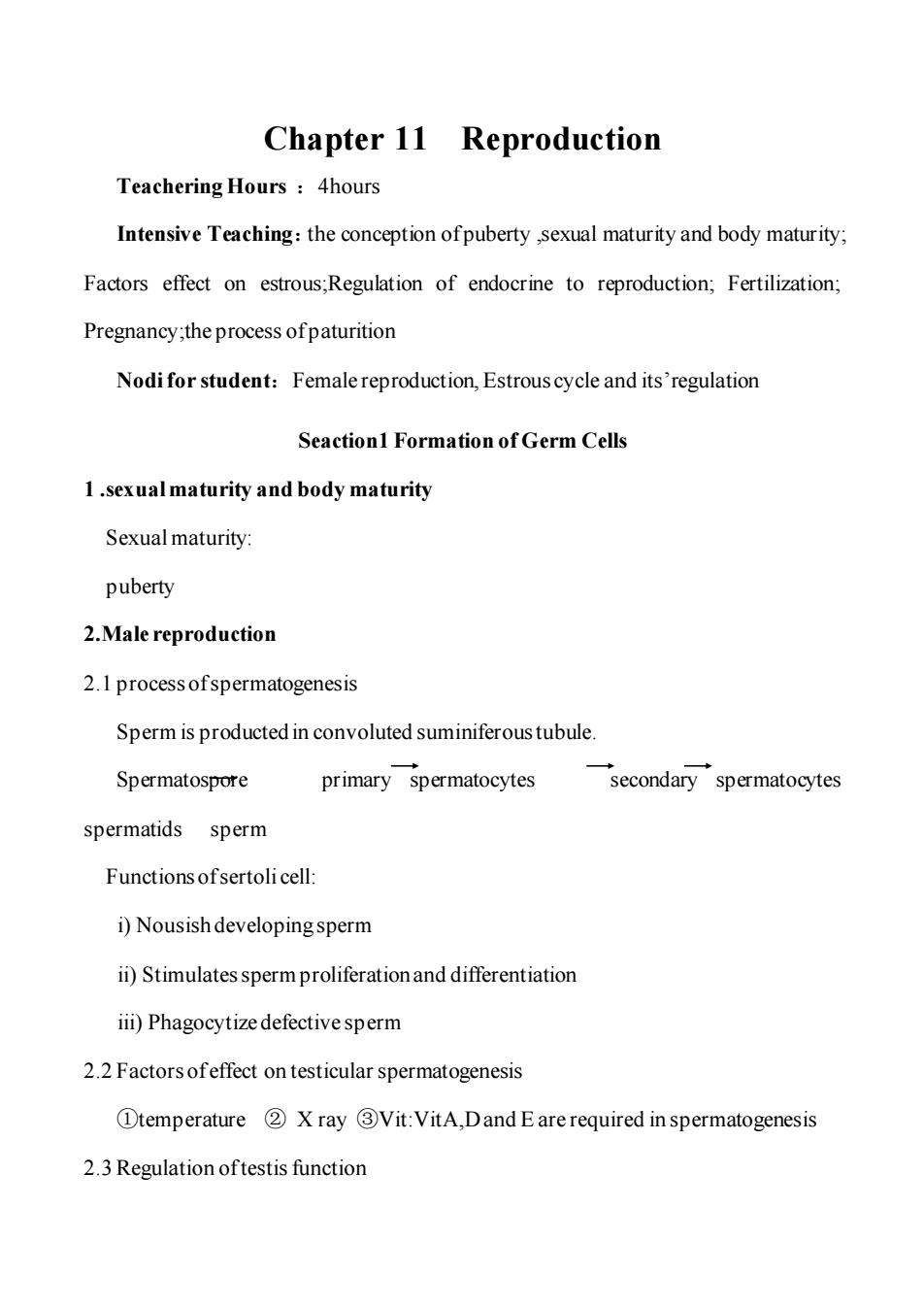
Chapter 11 Reproduction Teachering Hours 4hours Intensive Teaching:the conception ofpuberty ,sexual maturity and body maturity; Factors effect on estrous;Regulation of endocrine to reproduction;Fertilization; Pregnancy;the process ofpaturition Nodi for student:Female reproduction,Estrous cycle and its'regulation Seaction1 Formation of Germ Cells 1.sexual maturity and body maturity Sexual maturity: puberty 2.Male reproduction 2.1 process ofspermatogenesis Sperm is producted in convoluted suminiferous tubule Spermatospore primary spermatocytes secondary spermatocytes spermatids sperm Functions ofsertoli cell: i)Nousish developing sperm ii)Stimulates sperm proliferation and differentiation iii)Phagocytize defective sperm 2.2 Factors ofeffect on testicular spermatogenesis Dtemperature 2X ray 3Vit:VitA,Dand E are required in spermatogenesis 2.3 Regulation oftestis function
Chapter 11 Reproduction Teachering Hours :4hours Intensive Teaching:the conception of puberty ,sexual maturity and body maturity; Factors effect on estrous;Regulation of endocrine to reproduction; Fertilization; Pregnancy;the process of paturition Nodi for student:Female reproduction, Estrous cycle and its’regulation Seaction1 Formation of Germ Cells 1 .sexual maturity and body maturity Sexual maturity: puberty 2.Male reproduction 2.1 process of spermatogenesis Sperm is producted in convoluted suminiferous tubule. Spermatospore primary spermatocytes secondary spermatocytes spermatids sperm Functions of sertoli cell: i) Nousish developing sperm ii) Stimulatessperm proliferation and differentiation iii) Phagocytize defective sperm 2.2 Factors of effect on testicular spermatogenesis ①temperature ② X ray ③Vit:VitA,D and E are required in spermatogenesis 2.3 Regulation of testis function

Hypothalamus-pituitary-testis axis 3.Female reproduction 3.1 development ofthe follicle Primordial follicle primary follicle secondary follicle mature follicle 3.2 ovulation (1)types ofovulation:i)spontaneous ovulation ii)induced ovulation (2)Mechanism ofovulation During the late follicular phase,plasma estrogen increases to elicit a surge of LH,which then cause,completion of the egg's fist meiotic division and cytoplasmic maturation,ovulation. 3.3 The formation and degradation 3.4 Regulation ofovary action (1)Effect of LH and FSH on ovary i)LH stimatulates development offollicle ii)LH and FSH stimatulates estrogen secretion,promotes follicle matured and ovulation;promotes formation ofcorpus luteum and progesterone secretion. (2)Control ofhypothalamus to adenohypophysial (3)Feedback regulation ofovarian hormone Seaction2 Copulation and Fertilization 1.Estrous cycle(or sexal cycle): The time intervals from an ovulation to the next.Divide into proestrus,estrus, metestrus and diestrum
Hypothalamus-pituitary-testis axis 3. Female reproduction 3.1 development of the follicle Primordial follicle primary follicle secondary follicle mature follicle 3.2 ovulation (1) types of ovulation: i) spontaneous ovulation ii) induced ovulation (2) Mechanism of ovulation During the late follicular phase, plasma estrogen increases to elicit a surge of LH,which then cause,completion of the egg’s fist meiotic division and cytoplasmic maturation,ovulation. 3.3 The formation and degradation 3.4 Regulation of ovary action (1)Effect of LH and FSH on ovary i) LH stimatulates development of follicle ii)LH and FSH stimatulates estrogen secretion,promotes follicle matured and ovulation; promotes formation of corpus luteum and progesterone secretion. (2) Control of hypothalamusto adenohypophysial (3) Feedback regulation of ovarian hormone Seaction2 Copulation and Fertilization 1. Estrous cycle(or sexal cycle): The time intervals from an ovulation to the next. Divide into proestrus, estrus, metestrus and diestrum

Factors effect on estrous cycle: i)seasonal factors ii)feedstuff:nutritional factor iii)temperature iv)tempt of male to female animal. 2.copulation and Fertilization 2.1 Fertilization:Fertilization occurs when a few sperm are transported to the ampullae ofthe fallopian tubes and enter the ovum. 2.2 Location offertilization:ampullary portion ofthe tube 2.3 changes ofsperm before fertilization (1)sperm capacitation:The process that enables sperm to bind to the ovum. 2.4 process offertilization i)Sperm andovum encounter ii)sperm enter ovum:drill through corona radiate pellucid zone enter ovum iii)The formation ofmalepronucleus and female pronucleus iv)Gamete formated Seaction3 Pregnancy Pregnancy:The process in which the fertilized ovum eventually develops into a full term fetus. 1.Establishment ofpregnancy (1)egg cleavage (2)Implantation:The blastocyst reaches the uterus and attaches to the uterine wall, it involves interactions between the endometrium and embryo
Factors effect on estrous cycle: i) seasonal factors ii) feedstuff: nutritional factor iii) temperature iv) tempt of male to female animal. 2. copulation and Fertilization 2.1 Fertilization: Fertilization occurs when a few sperm are transported to the ampullae of the fallopian tubes and enter the ovum. 2.2 Location of fertilization: ampullary portion of the tube 2.3 changes of sperm before fertilization (1)sperm capacitation:The process that enables sperm to bind to the ovum. 2.4 process of fertilization i) Sperm and ovum encounter ii) sperm enter ovum: drill through corona radiate pellucid zone enter ovum iii) The formation of malepronucleus and female pronucleus iv) Gamete formated Seaction3 Pregnancy Pregnancy: The process in which the fertilized ovum eventually develops into a full term fetus. 1. Establishment of pregnancy (1) egg cleavage (2) Implantation: The blastocyst reaches the uterus and attaches to the uterine wall, it involves interactions between the endometrium and embryo

(3)formation ofplacenta Functionofplacenta:i)placement ofembryo development ii)Exchange ofsubstance iii)Endocrine function of placenta:secret chorionic gonadotropin;progesterone;extrogen 2.maintain ofpregnancy 3.The changes of female animal during pregnancy Section4 Paturition Delivery occurs by rhythmical contractions of the uterus which first dilate the cervix and then move the infant,follow by the placenta,through the vagina.The contractions are stimulated in part by oxytocin,released from the posteror pituitary in a reflex triggered by uterine mechanoreceptors,and by uterine prostaglandins
(3) formation of placenta Function of placenta: i) placement of embryo development ii) Exchange of substance iii) Endocrine function of placenta:secret chorionic gonadotropin;progesterone;extrogen 2.maintain of pregnancy 3.The changes of female animal during pregnancy Section4 Paturition Delivery occurs by rhythmical contractions of the uterus ,which first dilate the cervix and then move the infant, follow by the placenta,through the vagina.The contractions are stimulated in part by oxytocin,released from the posteror pituitary in a reflex triggered by uterine mechanoreceptors ,and by uterine prostaglandins